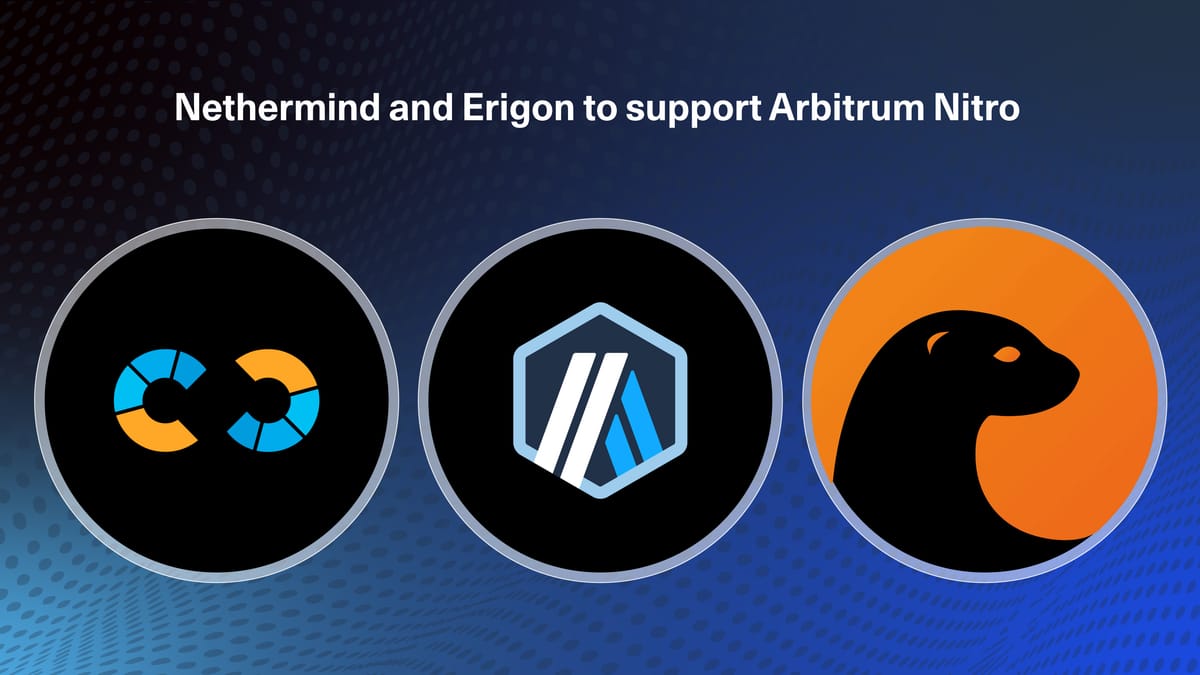Erigon and Nethermind Join Arbitrum

As Arbitrum scales, so too do the demands on the infrastructure which powers it. Having more apps, more users, and more chains isn’t just about going at faster speeds, though that is very important. It is, as we have noted in our scaling vision, also about building infrastructure that is flexible, sustainable, able to continuously evolve with Ethereum, and that brings Arbitrum Everywhere.
Today, alongside Nitro (which is based on go-ethereum or Geth), two new client teams, Erigon and Nethermind, will officially start development to support the Arbitrum ecosystem. These new client types will each have their own strengths and benefits. After all, it’s about finding the best ways to scale Arbitrum everywhere.
What are Execution Clients?
Execution Clients (EL) are independent software implementations of the Ethereum Virtual Machine (EVM) that are responsible for taking user transactions, executing them correctly, and appending those state changes to the blockchain ledger.
Similar to how there are different web browsers that allow you to access the same internet, each client implementation can offer varying benefits, with its own optimizations, architecture and features. Ethereum, for example, began with just one client: go-ethereum (Geth). But as it began to grow, so did the need for different types of clients. This is how Erigon and Nethermind came to be. Built by independent teams with its own unique architectures, offering new optimizations while running Ethereum.
Having multiple implementations can improve decentralization and minimize single point of failure. Up until now, Nitro, which is based on Geth, has been the only client that has been used for running Arbitrum chains. Nitro is fast, reliable, and has carried Arbitrum through many major milestones. But now that Arbitrum has matured, becoming one of the most widely adopted L2s today, the timing is right for additional clients.
These clients strengthen Arbitrum by reducing reliance on a single codebase as mentioned above, subsequently, this helps increase security and also enables additional validation of the chain's behavior. In addition to general security improvements, additional clients can open the door to performance improvements, new developer tools, and a wider range of use cases, including lightweight clients and more scalable infrastructure.
Introducing Nethermind and Erigon
Nethermind: High Performance, Lower Overhead
For node runners that have ever watched their RPCs lag, or sync times crawl, whilst simultaneously pulling out every last strand of hair from their scalp, well, Nethermind may be the client you need.
Marek Moraczyński, Head of Blockchain Engineering at Nethermind, says: “At Nethermind, our mission has always been to deliver an ultra-performant execution client that is secure, stable, and rigorously tested. This dedication has earned Nethermind a reputation for exceptional block processing speed, fast syncing and the trust of a broad user base. We’re excited to bring these strengths to the Arbitrum ecosystem. By using the Nethermind client as a sequencer, we aim to significantly boost the throughput of Arbitrum chains - ultimately contributing to Ethereum’s broader scalability.”
Nethermind has some key high-performance benefits based on its work with Layer-1 Ethereum:
- Faster Sync Times: Nodes come online much faster, which means reduced downtimes and operational overheads.
- Improved RPC Performance: Handles high-traffic data requests efficiently, making it ideal for applications that have demanding workloads. (e.g., fetching balances, checking token prices, and submitting transactions)
- Supports Higher Gas Targets: Built so that it can keep up with increased throughput, without having to update major hardware.
- Optimized for Speed: Designed to operate with top-tier performance with minimal latency.
The Nethermind team maintains a relentless focus on performance - continually experimenting with performance benchmarks to surface insights that improve the client.. Given these results on Ethereum, it’s easy to imagine the potential value Nethermind could bring to Arbitrum as well.
Erigon: Making Storage Much More Efficient
Most people know that running nodes is expensive, mainly because of its storage requirements, which require storage of sometimes terabytes of data…not exactly accessible for the everyday person. But fret not, with Erigon, this barrier to entry will exist no longer.
Giulio Rebuffo, CTO at Erigon, says “Our mission has always been to push the boundaries of Ethereum scalability and efficiency. We’ve worked tirelessly to optimize our archive nodes, delivering a 3x improvement in disk efficiency and RPC performance over our previous iterations, and a 25x improvement in both metrics compared to Geth. Doing this on Arbitrum aligns perfectly with this vision. By integrating Erigon's high-performance execution capabilities with Arbitrum's innovative Layer 2 solutions, we're setting new standards for throughput, cost-effectiveness, and decentralization.”
Here are some key benefits of choosing Erigon:
- Radical Storage Reduction: Based on its work with L1’s, Erigon can reduce disk space by up to 80%, when compared to traditional archival nodes.
- Accessible Infrastructure: Perfect for smaller teams, individuals or regional providers, allowing them to run full archival nodes at a much more affordable cost.
- Lower Hardware Costs: Significantly reduces infrastructure burden, making long-term node operation much more sustainable.
- Decentralization Friendly: Allows for broader participation in the network by reducing financial barriers
Same amount of data, way smaller footprint. Lower cost.
Let’s Build a Stronger Arbitrum, Together
Having Nethermind and Erigon help author the next chapters of the Arbitrum story unlocks significant performance improvements and cost reductions, but more importantly, it’s about building a stronger, more resilient Arbitrum.
With Nitro, Nethermind and Erigon all in the mix, Arbitrum will have real client diversity. This isn’t just another checkbox, but rather a critical step to building a stronger defense system against bugs, downtime and centralized dependencies.

